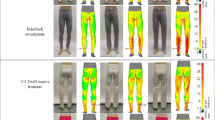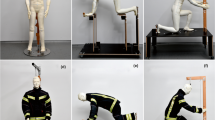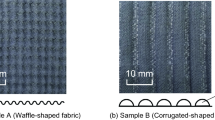Abstract
The heat and mass transfer in clothing is predominantly dependent on the thickness of air layer and the magnitude of contact area between the body and the garment. The air gap thickness and magnitude of the contact area can be affected by the posture of the human body. Therefore, in this study, the distribution of the air gap and the contact area were investigated for different body postures of a flexible manikin. In addition, the effect of the garment fit (regular and loose) and style (t-shirts, sweatpants, jacket and trousers) were analysed for the interaction between the body postures and the garment properties. A flexible manikin was scanned using a three-dimensional (3D) body scanning technique, and the scans were post-processed in dedicated software. The body posture had a strong effect on the air gap thickness and the contact area for regions where the garment had a certain distance from the body. Furthermore, a mathematical model was proposed to estimate the possible heat transfer coefficient for the observed air layers and their change with posture. The outcome of this study can be used to improve the design of the protective and functional garments and predict their effect on the human body.




Similar content being viewed by others
References
Aldrich W (1998) Obtaining repeatability of natural extended upper body positions: its use in comparisons of functional comfort of garments. Journal of fashion marketing& management 2(4):329–351
ASTM (D 1518:2010) Test method for measuring the evaporative resistance of clothing using a sweating manikin
ASTM (F 2370:2010) Measuring the evaporation resistance of clothing using a sweating manikin
Berger X, Sari H (2000) A new dynamic clothing model. Part 1: heat and mass transfers. Int J Therm Sci 39(6):673–683. doi:10.1016/S1290-0729(80)00211-6
Choi S, Ashdown SP (2011) 3D body scan analysis of dimensional change in lower body measurements for active body positions. Text Res J 81(1):81–93. doi:10.1177/0040517510377822
Dorman LE, Havenith G (2009) The effects of protective clothing on energy consumption during different activities. Eur J Appl Physiol 105(3):463–470. doi:10.1007/s00421-008-0924-2
Fan JT, Luo ZX, Li Y (2000) Heat and moisture transfer with sorption and condensation in porous clothing assemblies and numerical simulation. Int J Heat Mass Tran 43(16):2989–3000. doi:10.1016/S0017-9310(99)00235-5
Frackiewicz-Kaczmarek J, Psikuta A, Bueno M, Rossi RM (2014a) Air gap thickness and contact area in undershirts with various moisture contents: influence of garment fit, fabric structure and fiber composition. Text Res J. doi:10.1177/0040517514551458
Frackiewicz-Kaczmarek J, Psikuta A, Bueno M, Rossi RM (2014b) Effect of garment properties on air gap thickness and the contact area distribution. Text Res J. doi:10.1177/0040517514559582
Frackiewicz-Kaczmarek J, Psikuta A, Rossi RM (2012 ) Use of 3D body scanning technique for heat and mass transfer modelling in clothing. International Conference on 3D body scanning technologies Lugano, Switzerland
Grandjean EE (1980 ) Sitting posture of car drivers from the point of view of ergonomics. Human Factors in Transport Research 2:205-213
Havenith G, Heus R, Lotens WA (1990a) Clothing ventilation, vapor resistance and permeability index—changes due to posture, movement and wind. Ergonomics 33(8):989–1005. doi:10.1080/00140139008925308
Havenith G, Heus R, Lotens WA (1990b) Resultant clothing insulation—a function of body movement, posture, wind, clothing fit and ensemble thickness. Ergonomics 33(1):67–84. doi:10.1080/00140139008927094
Havenith G, Nilsson HO (2004) Correction of clothing insulation for movement and wind effects, a meta-analysis. Eur J Appl Physiol 92(6):636–640. doi:10.1007/s00421-004-1113-6
Hes L, de Araujo M (2010) Simulation of the effect of air gaps between the skin and a wet fabric on resulting cooling flow. Text Res J 80(14):1488–1497. doi:10.1177/0040517510361797
ISO (5084:1996) Textiles—determination of thickness of textiles and textile products
ISO (7730:2005) Ergonomics of the thermal environment—analytical determination and interpretation of thermal comfort using calculation of the PMV and PPD indices and local thermal comfort criteria
ISO (8559: 1989) Garment construction and anthropometric surveys—body dimensions
ISO (9073-1:1989) Textiles—test methods for nonwovens—part 1: determination of mass per unit area
ISO (9073-9:2008) Textiles—test methods for nonwovens—part 9: determination of drapability including drape coefficient
ISO (9920:2007) Ergonomics of the thermal environment—estimation of thermal insulation and water vapour resistance of a clothing ensemble
ISO (11226:2000) Ergonomics—evaluation of static working postures
ISO (15831:2004) Clothing—physiological effects—measurement of thermal insulation by means of a thermal manikin
Kirk W, Ibrahim SM (1966) Fundamental relationship of fabric extensibility to anthropometric requirements and garment performance. Text Res J 36(1):37. doi:10.1177/004051756603600105
Lee J, Ashdown SP (2005) Upper body surface change analysis using 3-D body scanner. Journal of the Korean Society of Clothing and Textiles 29(12):1595–1607
Li X, Wang Y, Lu Y (2011) Effects of postures on clothing air gap in protective clothing. Journal of fiber bioengineering & informatics 4(3):277–283
Li Y, Holcombe BV (1998) Mathematical simulation of heat and moisture transfer in a human-clothing-environment system. Text Res J 68(6):389–397. doi:10.1177/004051759806800601
Lotens WA, Havenith G (1991) Calculation of clothing insulation and vapor resistance. Ergonomics 34(2):233–254. doi:10.1080/00140139108967309
Mah T, Song GW (2010) Investigation of the contribution of garment design to thermal protection. Part 1: characterizing air gaps using three-dimensional body scanning for women’s protective clothing. Text Res J 80(13):1317–1329. doi:10.1177/0040517509358795
Mayor TS, Couto S, Psikuta A, Rossi RM (2014 ) Transport phenomena in clothing wavy microclimates Paper presented at the Ambeince 14 & 10i3m Tampere, Finland
Mayor TS, Couto S, Psikuta A, Rossi RM (2015) Advanced modelling of the transport phenomena across horizontal clothing microclimates with natural convection. International Journal of Biometeorology. doi:10.1007/s00484-015-0994-x
McCullough EA, Jones BW, Huck PEJ (1985) A comprehensive data base for estimating clothing insulation. ASHRAE Transactions 91(2A):29–47
Mert E, Psikuta A, Bueno MA, Rossi RM (2015) Effect of heterogenous and homogenous air gaps on dry heat loss through the garment. International Journal of Biometeorology 59(11):1701–1710. doi:10.1007/s00484-015-0978-x
Nielsen R, Olesen BW, Fanger PO (1985) Effect of physical-activity and air velocity on the thermal insulation of clothing. Ergonomics 28(12):1617–1631. doi:10.1080/00140138508963299
Oh AG (2008) The measurement of water vapour transfer rate through clothing system with air gap between layers. Heat and Mass Transfer 44(4):375–379. doi:10.1007/s00231-007-0258-3
Olesen BW, Sliwinska E, Madsen TL, Fanger PO (1982 ) Effect of body posture and activity on the thermal insulation of clothing: measurements by a movable thermal manikin ASHRAE Transactions 88 791-805
Oliveira AVM, Gaspar AR, Quintela DA (2008) Measurements of clothing insulation with a thermal manikin operating under the thermal comfort regulation mode: comparative analysis of the calculation methods. Eur J Appl Physiol 104(4):679–688. doi:10.1007/s00421-008-0824-5
Parsons K (2003) Human thermal environments—the effects of hot, moderate and cold environments on human health, comfort and performance second edn. Taylor & Francis Inc., London
Pheasant S (2003) Body space—anthropometry, ergonomics and the design of work, 2nd edn. Taylor & Francis
Psikuta A, Frackiewicz-Kaczmarek J, Frydrych I, Rossi R (2012) Quantitative evaluation of air gap thickness and contact area between body and garment. Text Res J 82(14):1405–1413. doi:10.1177/0040517512436823
Psikuta A, Frackiewicz-Kaczmarek J, Mert E, Bueno M, Rossi RM (2015 ) Validation of a novel 3D scanning method for determination of the air gap in clothing Measurement doi:10.1016/j.measurement.2015.02.024
Spencer-Smith JL (1977) The physical basis of clothing comfort. Part 2—heat transfer through dry clothing assemblies. Clothing Research Journal 5(1):3–17
Takada S, Hokoi S, Kawakami N, Kudo M (1999) Effect of sweat accumulation in clothing on transient thermophysiological response of human body to environment. Building simulation proceedings 1:385 - 392
Umeno T, Hokoi S, Takada S (2001 ) Prediction of skin and clothing temperatures under transient considering moisture accumulation in clothing. ASHRAE Trans 107 71 - 81
Wang X, Bullock MI (2004 ) Pedal operation, preferred postures for driving In: Delleman NJ, Heslegrave CM, Chaffin DB (eds) Working postures and movements-tools for evaluation and engineering CRC Press
Winslow CEA, Gagge AP, Herrington LP (1939) The influence of air movement upon heat losses from the clothed human body. Am J Physiol 127(3):505–518
Wu YS, Fan JT, Yu W (2011) Effect of posture positions on the evaporative resistance and thermal insulation of clothing. Ergonomics 54(3):301–313. doi:10.1080/00140139.2010.547604
Author information
Authors and Affiliations
Corresponding author
Rights and permissions
About this article
Cite this article
Mert, E., Psikuta, A., Bueno, MA. et al. The effect of body postures on the distribution of air gap thickness and contact area. Int J Biometeorol 61, 363–375 (2017). https://doi.org/10.1007/s00484-016-1217-9
Received:
Revised:
Accepted:
Published:
Issue Date:
DOI: https://doi.org/10.1007/s00484-016-1217-9




